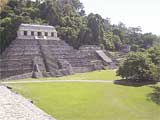Chiapas bases economy on agriculture

The pyramid that holds the body of an ancient Mayan king. The size of ht epyramid represents the importance the king had for the city.
Chiapas is located in the Southeastern part of Mexico bordering Guatemala to the South. Its land mass extends more than 75 thousand square kilometers, and its characteristics of soil and climate make its agricultural potential nearly unlimited.
The state is Mexico’s leader in the production of coffee, sugar cane, bananas and mangos.
The State’s population accounts for 3.5 million citizens of which 45 percent live in urban settings such as San Cristobal de las Casas, Comitan de Dominguez, Tuxtla Gutierrez y Tapachula. The Chiapan population is characterized by its youth, more than 40 percent are under the age of 15, and the median age is 18.
Culturally the state also has as rich a past as any in the world. Chiapas was home to cities in which the ancient Maya culture flourished from 600 to 900.
In particular the state was home to ancient ceremonial sites such as Palenque, Bonampak, Tonina and others based in the Lacandona jungle.
The Mayan culture is noted in modern days because of its scientific advances. For example, its architecture, its knowledge of engineering and mathematics and also its extraordinary astronomical predictions.
In its natural environment, the determined Mayan farmer domesticated corn, beans, pumpkins, avocados and coffee, which made and continue to make with terrestrial and aquatic faun a complete diet.
The Mayan ancestors based their economies in the cultivation of their land and in the raising of pigs, cows and land birds.
When the Spanish began the Conquest of Mexico, more than 500 years ago, the Mayan population did not surpass 100,000 people. Today, however, the heirs of that culture add up to more than 1.4 million people in Chiapas only.
The indigenous population represents approximately 36 percent of the state’s population and mainly resides in rural areas.
The indigenous people are broken up in to 10 different ethnic groups: the Tzeltales, Tzotziles, Choles, Lacandones, Zoques, Tojolabales, Mames, Chujes, Ceckchiqueles and Mochos.
The Tzolziles and the Tzeltales are most noted for their size. They reside near San Cristobal de las Casas.
The Tzotziles found townships in Chamula and Zinacantan and the Tzeltales in Copanaguastla,
Out of the 10 different ethnic groups in Chiapas there is only one that doesn’t have the Mayas as ancestors, the Zoques, and they have the Olmecs as their ancestors.
The religious demonstrations of the indigenous people of Chiapas are of particular interest. Although they are very diverse, they adopted the religious beliefs of Mexico’s colonial period while also maintaining their pre-Hispanic idolatry rooted in natural phenomena. They have kept their respect of their ancestors, the legends of deities and the duality of animals, plants, caves and rivers.
They have maintained the practice of ritual dances. Representations of good and evil, the use of color as a mystical tool and musical expressions are manifestations that they have survived to reaffirm the identity and cosmogony of each group.
The ethnic groups living in Chiapas today are vivid expressions of ancient culture, which is by no means extinct. They preserve their customs, their languages, their traditions, their manners of social organization, their traditional clothing and their values.
All this has prevailed during centuries.
Your donation will support the student journalists of Missouri Southern State University. Your contribution will allow us to purchase equipment and cover our annual website hosting costs.



























